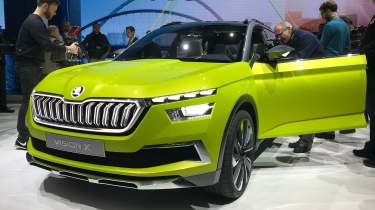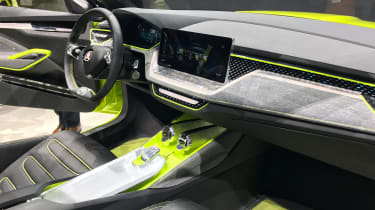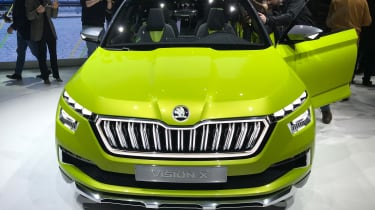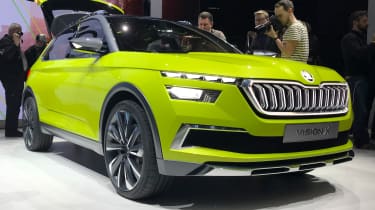Skoda Vision X concept SUV revealed at Geneva motor show
Skoda's Geneva concept car is the Vision X and serves as a preview for the firm's hybrid powertrain future
Skoda has pulled the covers off its Vision X crossover concept at the 2018 Geneva motor show. A production version of the new compact crossover hasn’t yet been officially announced, but the concept almost certainly previews a production car that will share its platform, if not necessarily its proportions and styling cues, with the Volkswagen Group’s other compact crossovers from VW and SEAT.
More importantly, the Vision X is being used as a demonstration of some of Skoda’s upcoming design cues and technological developments that will spread across the range in due course. Those include a hybrid, all-wheel drive powertrain fuelled by compressed natural gas, and a new interior and dashboard layout that’s both more advanced and more imaginative than Skoda’s current cabins.
Skoda’s electrified future
The powertrain is one of the first steps in Skoda’s low-emissions roadmap with the aim of reducing fleet-wide CO2 to no more than 66.5g/km by 2030. A large part of this will involve electrification, but Skoda is taking a leaf from its Group partner Audi and looking towards E-fuels, with natural gas generated from renewable sources in particular one of the brand’s goals.
This involves extracting CO2 from the atmosphere and combining it with hydrogen (extracted from electrolysis, itself powered via renewable sources) to create methane and oxygen byproducts, the former of which can be used to power combustion vehicles.
The benefit of this, says Skoda, is that it significantly reduces the “well-to-wheels” carbon footprint of its vehicles - and indeed, other combustion vehicles too, for an instant gain in terms of greenhouse gas emissions. It’s effectively the same goal that Mazda is aiming for with the compression ignition technology we recently sampled - cleaning up existing combustion engines for short- to mid-term gains - albeit by taking the route of improving the fuel rather than the engines themselves.
Vision X then combines this combustion technology (which can run on regular petrol fuel as well) with mild hybrid technology. A 48-volt electrical system powers both a belt-driven starter/alternator on the engine and a 27bhp electric motor and transmission on the rear axle, to supply part-time all-wheel drive and short-range, low-speed electric running.
> Skoda Kodiaq vRS coming next year?
Skoda confirmed to evo that these electric systems won’t replace the firm’s conventional, Haldex-type all-wheel drive systems for the time being. It suggested that while it will make all-wheel drive available to a wider client base - and offer extra traction across a wide range of scenarios - higher-torque, higher-speed requirements are still best served by a conventional, mechanical all-wheel drive setup.
A production version of the Vision X would be capable of CO2 emissions of 89g/km, in addition to the traction benefits of all-wheel drive. For reference, the similarly compact SEAT Arona doesn’t dip below 105g/km even in its diesel variants.
Using a 1.5-litre CNG-powered and turbocharged four-cylinder (with 128bhp at its disposal), 0-62mph is quoted as 9.3sec and top speed is 124mph - figures which are competitive for the class, albeit slower than the petrol-only 1.5-litre 148bhp Arona.
> SEAT launches new Cupra performance brand
The tech is just one aspect of Skoda’s future powertrain plans, which range from mild hybrids (starter/generator only), through “mild hybrid plus” (starter/generator and short-range battery), hybrid (larger battery), plug-in hybrid (larger battery still and plug-in capability) and full battery electric vehicles.
Skoda’s first plug-in hybrid, due in 2019, will be based on the Superb, packing 215bhp of system power and able to travel around 43 miles in pure electric mode.
Skoda Vision X design
Skoda will unveil its concept in full at the Geneva motor show, but has revealed a few extra details about the design both inside and out that aren’t possible to discern from the initial images shown here.
The company has once again looked to its local heritage for inspiration for the more ornate glass elements, but this time that isn’t just limited to the intricate details of the headlights and tail lights.
With the Vision X, the grille and its surround are also cut glass - though should details such as that make it anywhere near production, we’d expect them to be fashioned from something a little less fragile. With the headlights themselves, Skoda’s recent trend on its SUVs for split-level lights has been reversed, with the main lighting element now at the bottom of the pair and DRLs and indicators handled by the slim upper portion.
Inside, the design of the dashboard is all new and should influence future Skoda models. The layout is cleaner and less dour than before, with a split-level design that puts a free-standing screen central in the dashboard (reminding us a little of the Toyota C-HR, or perhaps more favourably, the BMW i3) and a long centre console below it - featuring more cut glass.
Concept-specific cabin details are more apparent at the rear, where the boot is filled with a pair of electrically-assisted skateboards, and a drone - part of what Skoda describes as a “last mile” transport solution - think the stretch between wherever you park your car and the entrance of your workplace.








